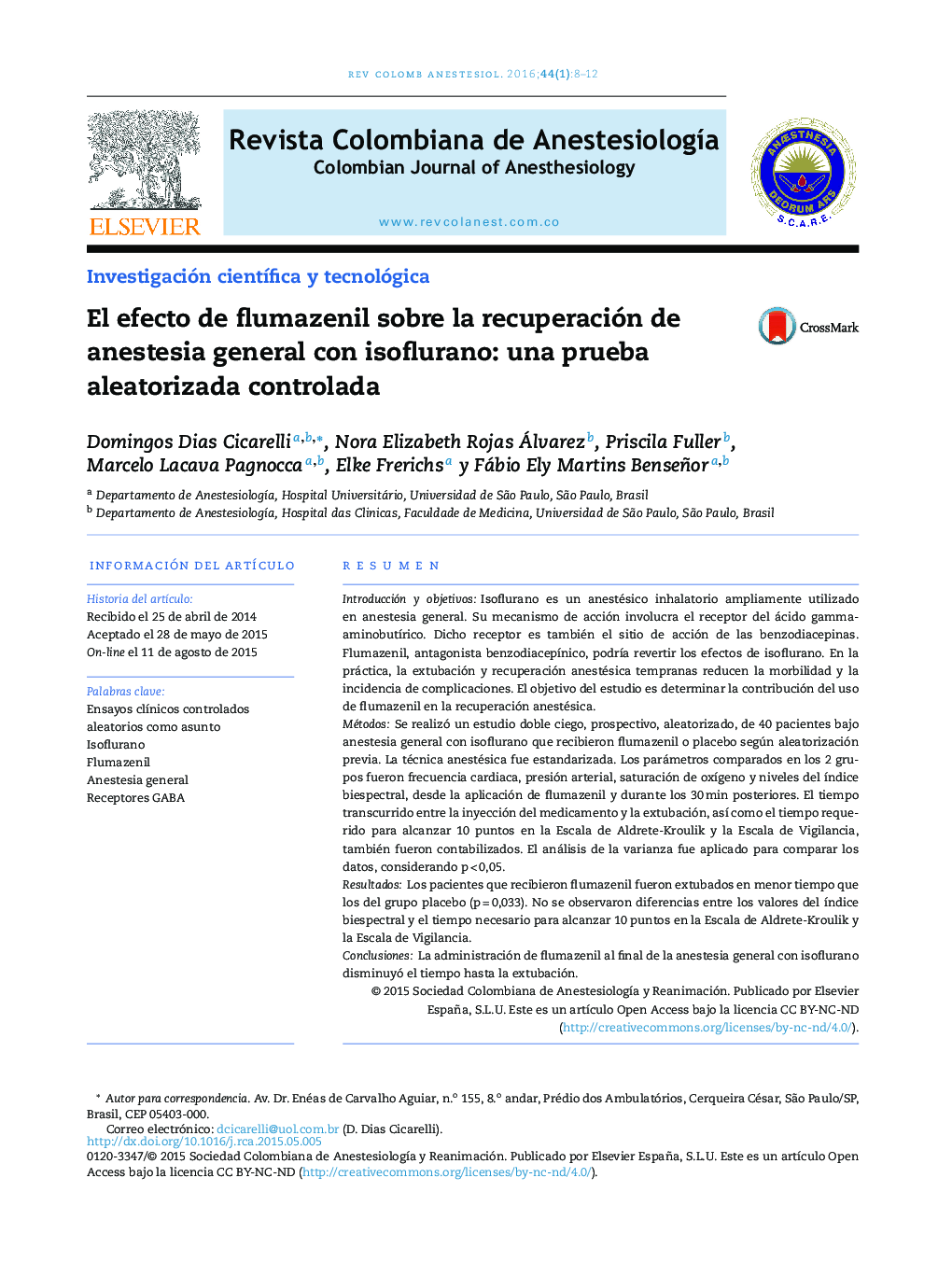| Article ID | Journal | Published Year | Pages | File Type |
|---|---|---|---|---|
| 2767607 | Revista Colombiana de Anestesiología | 2016 | 5 Pages |
ResumenIntroducción y objetivosIsoflurano es un anestésico inhalatorio ampliamente utilizado en anestesia general. Su mecanismo de acción involucra el receptor del ácido gamma-aminobutírico. Dicho receptor es también el sitio de acción de las benzodiacepinas. Flumazenil, antagonista benzodiacepínico, podría revertir los efectos de isoflurano. En la práctica, la extubación y recuperación anestésica tempranas reducen la morbilidad y la incidencia de complicaciones. El objetivo del estudio es determinar la contribución del uso de flumazenil en la recuperación anestésica.MétodosSe realizó un estudio doble ciego, prospectivo, aleatorizado, de 40 pacientes bajo anestesia general con isoflurano que recibieron flumazenil o placebo según aleatorización previa. La técnica anestésica fue estandarizada. Los parámetros comparados en los 2 grupos fueron frecuencia cardiaca, presión arterial, saturación de oxígeno y niveles del índice biespectral, desde la aplicación de flumazenil y durante los 30 min posteriores. El tiempo transcurrido entre la inyección del medicamento y la extubación, así como el tiempo requerido para alcanzar 10 puntos en la Escala de Aldrete-Kroulik y la Escala de Vigilancia, también fueron contabilizados. El análisis de la varianza fue aplicado para comparar los datos, considerando p < 0,05.ResultadosLos pacientes que recibieron flumazenil fueron extubados en menor tiempo que los del grupo placebo (p = 0,033). No se observaron diferencias entre los valores del índice biespectral y el tiempo necesario para alcanzar 10 puntos en la Escala de Aldrete-Kroulik y la Escala de Vigilancia.ConclusionesLa administración de flumazenil al final de la anestesia general con isoflurano disminuyó el tiempo hasta la extubación.
Background and objectivesThe inhalational anesthetic isoflurane is widely used in general anesthetics. Its mechanism of action involves interaction with the receptor of gamma-amino butyric acid, which is also the binding site for benzodiazepines. Flumazenil, benzodiazepine antagonist, reverses the effects of these drugs in gamma-amino butyric acid receptors and could therefore also reverse the effect of isoflurane. In anesthesia practice, extubation and early anesthetic recovery reduce morbidity and incidence of complications. The objective of this trial is to determine whether the use of flumazenil may contribute to faster recovery from anesthesia.MethodsForty patients scheduled to undergo general anesthesia with isoflurane were enrolled in this prospective, double-blind, randomized trial. Patients were randomized to receive, at the end of anesthesia, flumazenil or placebo as allocated into 2 groups. The anesthetic technique was standardized. The groups were compared concerning values of Cerebral State Index, heart rate, blood pressure and oxygen saturation from the application of flumazenil or placebo until 30 min after injection. Data regarding time to extubation, time to reach 10 points in the Aldrete-Kroulik score and Vigilance score was also collected. ANOVA test was applied to analyze the results, considering P < .05.ResultsPatients receiving flumazenil achieved faster extubation than the control (P = .033). No differences were observed in values of Cerebral State Index, the time until Aldrete-Kroulik = 10 and until Vigilance score = 10.ConclusionsAdministration of flumazenil at the end of isoflurane general anesthesia resulted in earlier extubation in studied patients.
